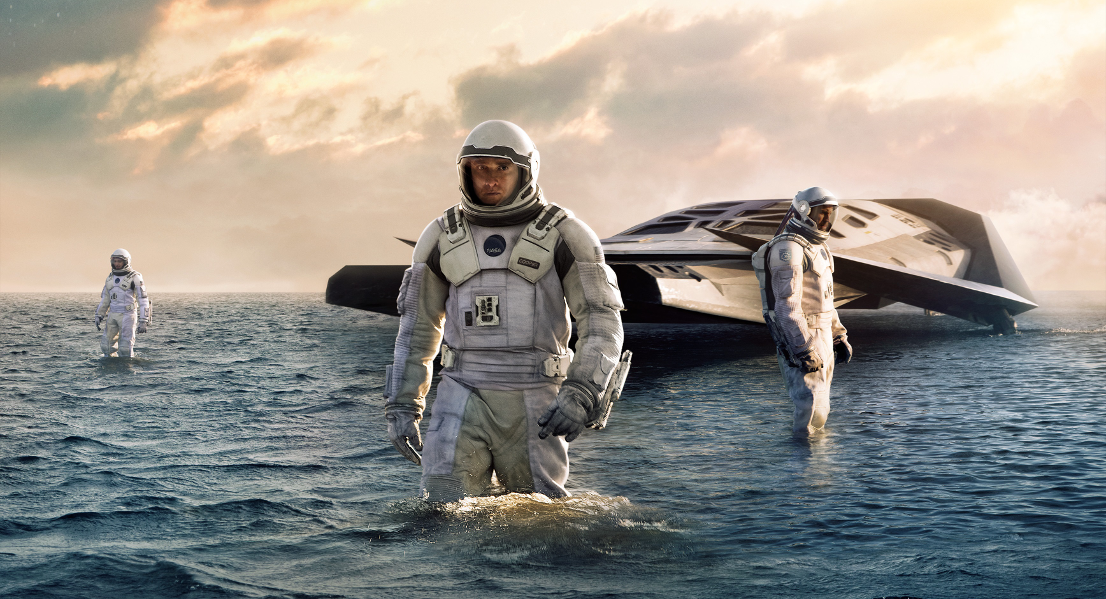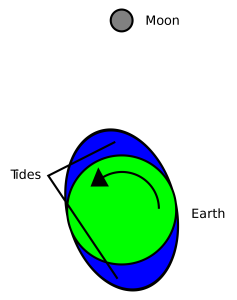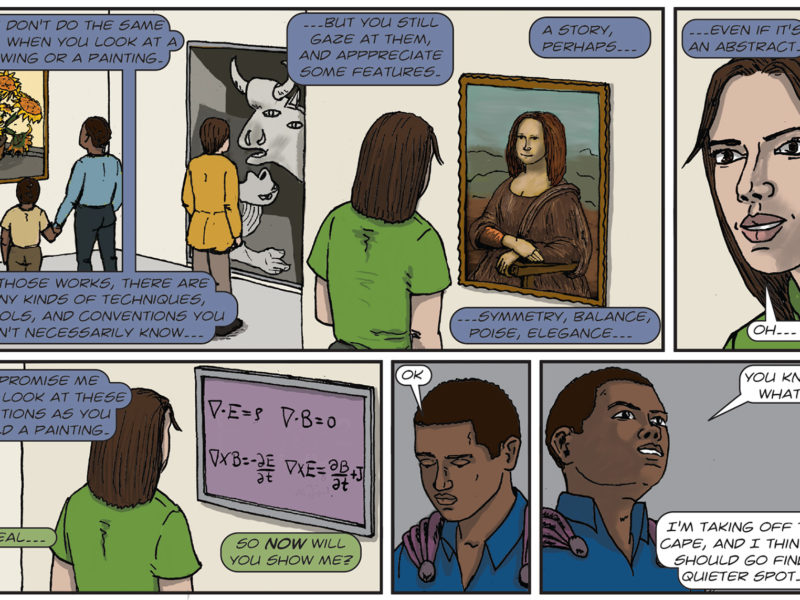In the movie Interstellar, Joseph Cooper (Matthew McConaughey) lands the Ranger 1 on Miller’s planet, a water world orbiting the supermassive black hole, Gargantua. Initial scans show the planet rich with the organic molecules, water, and sunlight necessary for life. Instead, what the team encounters is a shallow water world with 1.2-kilometer high waves. These two conditions render the planet sterile and possibly incapable of supporting life.
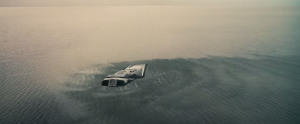
The massive tidal waves seen on Miller’s planet are due to its proximity to Garguanta. The gravitational attraction of this black hole is so strong that it creates huge swells of water that literally reach the sky. Though spectacular and certainly dramatic, the effect is a familiar one and one we see on Earth in the form of tides. Tides on Earth are the result of the combined gravitational attraction of the Earth and the Moon. The question is, are the huge waves on Miller’s planet even possible?
The Tidal Force
Isaac Newton was the first person to explain tides as a product of gravitational attraction between the Earth and the Moon, an explanation he published in the Principia in 1687. The Moon's gravity causes ocean tides on Earth and there are usually two high tides or two low tides each day. While we expect there to be a high tide on the Moon-side of Earth, or the “sublunar” side as seen in the diagram, it is not intuitively obvious why a second bulge on the opposite side (antipodal) exists.
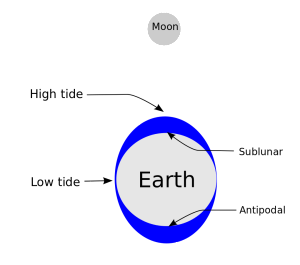
The Moon’s gravitational force weakens with distance. Though the diameter of the Earth—about 12,742 km (7,926 miles)—is small, the effect is significant; the Moon tugs more on the sublunar side than the antipodal. This disparity is known as the tidal force and it stretches the Earth from a sphere to something oblong. The result is that the Earth looks more like an American football than an actual football.
The Moon’s gravity does not only pull on the Earth’s mantle but also its oceans. The water over the sublunar side is closer and is pulled towards the Moon faster than the solid mantle beneath, creating a bulge. On the opposite (antipodal) side, something different happens. The water is not pulled as much as the solid rock below and gets “left behind.” This results in a water bulge on the far side of the Earth.
The same thing happens on Miller’s planet but with much greater effect. Gargantua is much bigger than our Sun–about 100 million times more massive–and its tidal force is much greater than what we see between the Moon and the Earth. The result is the 1.2 kilometer (0.75 miles) high wave in the film. As spectacular as this sounds, there lies a problem. As the planet rotates, tidal forces constantly flex the planet’s crust and generate heat. While this effect is small on Earth, it will be huge on Miller’s planet. Instead of a molten planet devoid of water, we see a watery world. Did the movie get it wrong, or is there more to the physics?
Tidal friction on Earth and Miller’s planet
It turns out there is more to the physics. In reality, on our planet, the Earth’s tidal bulge does not lie directly under the Moon. As the Earth rotates, it drags the bulge forward. This has two consequences. A substantial mass now lies offset from the line connecting the centers of the Earth and Moon which pulls on the Moon and drags it forward, giving it more kinetic energy. This added kick means the Moon is slowly drifting away from us. The Moon also pulls on the Earth’s bulge, dragging it back, taking away its rotational energy and lengthening the Earth’s day.
On Miller’s planet, this continuous moving of the crustal bulge flexes and pulverizes the mantle and friction eventually heats it up. Not surprisingly, this effect is known as “tidal heating.” Io, one of Jupiter’s moons, is the most volcanically active body in the solar system due to its tidal dynamics and friction with Jupiter. Science does provide a way out: tidal locking.
The Face of Tidal Locking
As we look up at the Moon, we notice that the same side always faces our planet. This is because the Moon is “tidally locked” with the Earth; the Moon rotates about its axis in the same time it takes to revolve around our planet. Tidal locking occurred because of tidal friction. In the same way the Moon is currently slowing the Earth’s rotation and lengthening the day, long ago, because of its smaller size tidal friction slowed the Moon’s rotation to where one side always faces our planet.
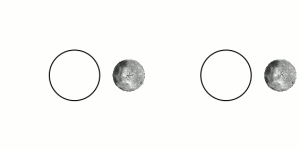
If Miller’s planet is tidally locked with Garguanta, then the massive black hole will not flex its surface, heating it through tidal friction until it is a molten sphere. In this case, the planet’s bulges will always be in line with its center and the black hole. Has physics has given us an answer to the dramatic scene in the movie? In the movie, Cooper sees the massive wall of water head towards the craft. This will not be possible if the planet is tidally locked with the black hole, as all they will still see is a stationary wall of water; the bulges are always in line with the planet’s center and Garguanta.
A tidal locked planet would have been good news for Miller. She would have just landed on the planet safely to find her planet was unsuitable for inhabitation. Dr. Amelia Brand (Anne Hathaway) and Cooper would arrive soon after, a result of the extremely large time dilation due to Garguanta. Those huge tidal bulges should be stationary and pose no danger. Instead, Miller was killed by a huge tidal wave. So, is there physics bad or did Christopher Nolan use artistic license for dramatic effect. Well, it turns out science may have an answer.
Miller’s Planet is (Sort of) Tidally Locked
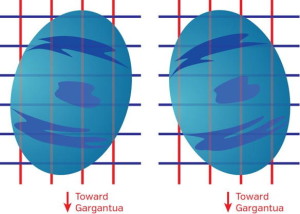
It turns out that science does indeed provide a way out. Science advisor and Caltech Theoretical Physicist, Kip S. Thorne, writes in his book The Science of Interstellar, that Miller’s planet is not quite locked to Garguanta. Instead, it rocks back and forth by a small amount. This oscillation is a result of Garguanta’s tidal forces and we have seen previously that an astronomical body can pull on the masses of the tidal bulges, slowing it down and eventually tidal locking it. Instead, when Miller’s planet is tilted to the left, Garguanta’s gravity pulls it to the right. When the planet moves to the right Garguanta pulls it back to the left. In many ways, Miller’s planet oscillates like a mass on a spring and this results in a back and forth wobbling motion of the planet.
This oscillation is small enough that, though it flexes the planet’s mantle, it does not pulverize it. That does not mean that frictional forces do not heat the mantle. It does. The effect is just small. Dr. Brand describes the planet as having a smell of distilled water poured on hot rocks. This could possibly be due to the small but significant tidal friction taking place on the planet.
This constant rocking back and forth of Miller’s planet under Garguanta’s intense tidal force means that those gigantic waves slosh about on the planet’s surface. We see the team trudging through a shallow ocean, not because the planet lacks water but because most of it is concentrated in huge bulges at the sublunar and antipodal sides.
The Science and Interstellar Tidal Waves
And there we have it. The massive waves on Miller’s planet are really huge tidal bulges. The planet, rather than rotating about its axis wobbles which sloshes the bulges about. Given such inhospitable conditions, it is not surprising that the group decides to check a new planet—Mann’s planet. It turns out that the scene on Miller’s planet has some serious science behind it and not written only for dramatic effect.
Check some of our other articles
- Did Rose murder Jack in the Titanic drowning scene?
- Staying warm with a box of radiation on 'The Martian'
Also published on Medium.

